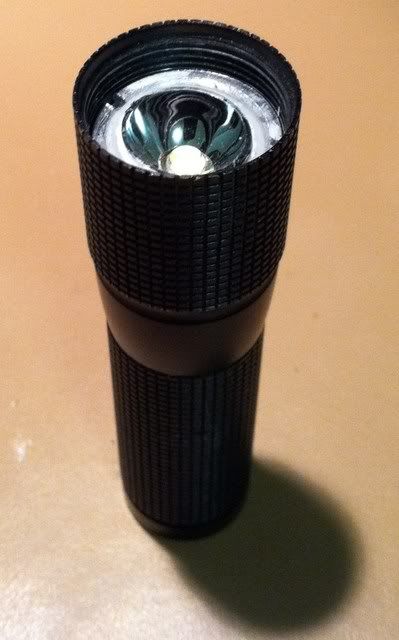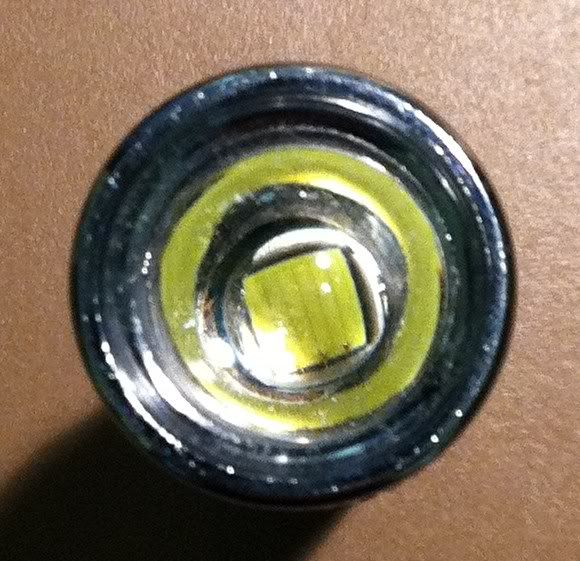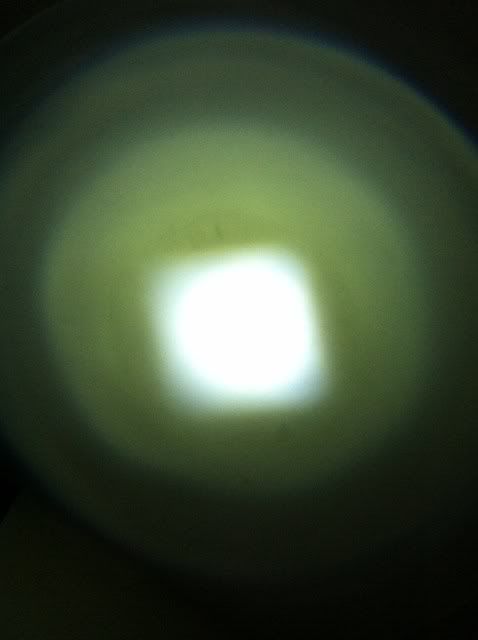Interesting idea. Here are some of the zoom mechanisms I've seen or read about:
1. Aspheric lens
I think the reason why aspherics are common is that they are cheap and easy to build. The body of a typical aspheric lens flashlight is very simple with a main body section and a sliding section. The lens can be ordered from a lens manufacturer in a standard size so no additional engineering is needed for the optics.
Most aspheric lens lights don't even come with reflectors probably making them even easier to engineer than conventional lights. The only one I've read about that comes with a manufacturer installed reflector behind the aspheric is the very non-budget Wolf-eyes Krait.
In addition to being cheap, it's also possible to make aspheric lens flashlights very small. This makes them good for EDC carry even with the inefficiency. A well-designed aspheric lens lights can also produce a fairly nice beam: a perfectly smooth even flood with no noticeable hotspot (if no reflector is used) that narrows down to a laser-like projection of the emitter die in spot mode.
The downside of aspheric lens flashlights is that only light that goes through the lens is outputted. In zoom mode, the lens is moved further away from the LED. Especially in smaller aspherics, this results in a ton of light lost as it gets absorbed into the side of the zoom section's casing rather than going through the lens. You can immediately see the loss of output in a ceiling bounce. Turn off all the lights, take a Sipik SK68 and point it at the ceiling. Look at the floor. Move the bezel to zoom mode and watch the floor immediately dim.
2. Moving reflector:
This is what the classic maglite incandescent lights had. A few early LEDs also use this method. The idea is to have the emitter mounted onto the flashlight body. The head contains a conventional reflector and non-aspheric lens. The reflector can be screwed or unscrewed taking the emitter off the reflector's focal point which should move the light from spot to flood.
I haven't seen this method used effectively with a modern LED light. To get a really effective zoom, the LED would need to be mounted on a narrow post, which means a conventional star cannot be used, and the LED might overheat due to lack of heatsinking. The few lights I have seen using this method tend to produce a very ringy beam in flood mode, and their range of angles going from spot to flood is far weaker than an aspheric.
The biggest advantage of this method is that in theory much less light would be lost switching modes than with an aspheric. The reflector would be there to catch any light emitted to the sides of the die.
3. Moving TIR (Total Internal Reflection).
One of the 18650 Romisen lights uses this method I think. Basically the same as the moving reflector method except that instead of a conventional reflector a TIR optic is used. A typical TIR optic consists of a solid chunk of plastic in the shape of a reflector, possibly with a vertical hole in the center for the emitter. Light passing into the TIR from the emitter bounces off the inner edge of the reflector and then passes forward through the front of the TIR. The principle is the same as how a typical automotive or bicycle reflector works even though they do not have reflective silver coatings.
By mounting the LED on a post and then moving the TIR up and down around it, the LED can be moved off of the TIR's focal point, thus widening the beam for flood mode. Since the TIR is catching light that is being emitted sideways, in theory much less light should be caught into the sides of the casing than with a traditional aspheric.
4. Multiple emitters
This method is used on one of the Ultrafire recoil throwers. In a recoil thrower the LED is mounted on an arm in front of a reflector. The emitter faces backwards into the reflector, allowing for a much more focused beam than with a traditional light where the emitter is mounted at the base of the reflector. The manufacturer chose to mount a second emitter on the front of the arm. The second emitter is right behind the lens and has no reflector at all, producing an incredibly wide even flood.
Activate one emitter for flood, and the other for spot mode. There is no in-between halfway mode.
The downside of this method is that any heatsinking to the emitter has to go down the narrow arm so the light cannot be driven very hard or it will overheat. Also to make an effective recoil thrower typically means a larger light. So this method wouldn't work for making an EDC light.
5. Reflector lens
This method is used by LED lensers. A small plastic aspheric lens in the center of a flat lens is mounted on a moving bezel. The area near the base of the emitter below the lens has no reflector. However, just beyond that area is a small conventional reflector designed to catch some of the sidespill and reflect it forward through the flat non-aspheric portion of the lens.
Output should be a combination of conventional reflector flashlight with some zooming from the aspheric lens. I don't own one myself, but have read that LED lensers have a very smooth beam, even if they are underpowered by today's standards and for the most part lack proper drivers.
______________________
Your idea for a deformable reflector is an interesting one, but not one I'd expect to see anytime soon, if ever. Conventional reflectors typically rely on a small coating of evaporated silver on the face of the reflector to provide the actual reflections. This coating isn't very flexible. It put on a flexible plastic there might be issues of it cracking or pealing rather than bending. Flexible reflective surfaces are probably either more expensive or much less efficient (think of the silver Mylar in a party balloon).
Engineering a piece of rubber into the shape of a reflector that is precise enough to give a smooth focused beam would also be very difficult. Especially if that piece of rubber is then constantly deformed as the light is cycled between modes.
Another option might be rather than having the reflector made from flexible material, it could instead be made out of pie-pieces of conventional material mounted on small hinges. Here's one idea I just thought of: Have a reflector focused for throw assembled in wedges that are hinged around the base of the emitter and spring loaded to stay in position. As you screw the light into flood mode, the lens will move closer to the reflector. When the reflector wedges hit the lens, the pressure of the lense would then cause them to slide apart on their hinges creating a flatter reflector suited for flood. A wider shallower reflector would be mounted behind the wedges to catch any light falling through the gaps. It might even have recesses for the reflector wedges.
However, this would be pretty expensive, would require lots of parts, and would probably produce an incredibly ugly beam even with an aggressive orange peal texturing. The head would also be quite wide.
Any of these options would likely require some very unusual engineering expertise. You wouldn't be able to do it with off the shelf parts like you can with a budget aspheric.




